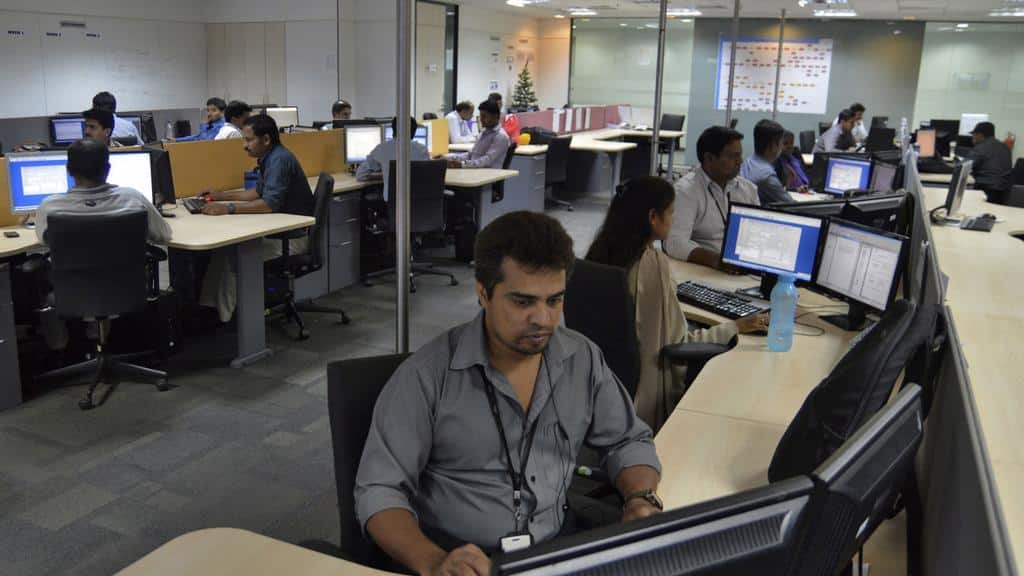A modern organization doesn’t need many people to deliver value.
4 of America’s 5 most valuable companies – Google, Facebook, Apple, and Microsoft – have 160,000 employees or less. Yet despite their small size, all these companies produce incredible work at scale.
This is illustrative of two important trends. First, modern organizations can get a lot done with a few people.
Second, repetitive tasks (like the ones common in Big Tech) are easy to outsource or automate. Case in point: Apple’s Chinese factories, Facebook bots, and Google’s overseas offices.
The question is, how can you apply outsourcing and automation to your own business? How do the two similar, how are they different and how can you use them in concert?
Let’s dive in, starting with…
How (and Why) Businesses Are Delegating Tasks To Robots & Overseas Workers
“Outsourcing” means hiring a third party to carry out a task that used to be internal. It doesn’t technically involve workers from abroad. But when we use the term in 2020, we almost always mean outsourcing overseas – or offshoring.
That’s because outsourcing abroad is so ubiquitous, with US overseas affiliates employing over 14,3 people. Add those working for US firms rather than affiliates and the number rises. In California alone, 500,000+ jobs have been outsourced to China since ‘01.
Two key reasons for this outsourcing boom are cost savings and improved productivity. Outsourced employees are often just as qualified as local ones at a fraction of the price. This makes them a valuable asset.
But outsourcing isn’t the only way to save money and get more work done. Business process automation (BPA) confers the same core benefits: lower costs, more work is done.
The difference is that automation uses robots – pieces of code, not the Transformer kind – rather than overseas workers.
Today, automation is in its infancy. But according to Harvard’s Lawrence Katz,
“over the long haul, clearly automation’s … much more important [than outsourcing] – and it’s not even close”.
Other experts estimate that as many as 375 million human jobs will soon be automated via BPA.
The question is, are outsourcing and automation competitors – or complementary business tools? What are the pros and cons – and use cases – of each? And will one eventually replace the other?
In answering all these questions, we’ll start by looking at…

The Pros & Cons of Outsourcing
Outsourcing – especially outsourcing abroad – is the original way to delegate work to third parties. Below are its main advantages and disadvantages.
Pros
Bigger Talent Pool
About 36% of US residents have higher education degrees. The figures for Russia and China are 83% and 60%+ respectively. These countries (and others) may be less developed than the US – but the workers there are talented and educated.
“If I need a few talented team members for an important task, I prefer to hire from the US, Europe and let’s say Israel and South Korea”, says GetVoIP founder Reuben Yonatan. “But if I need staff at the budget and at scale, I can’t limit myself to just these countries… [Because] finding 10 outstanding coders in the US coders can take months – but if I expand to Belarus and India, the positions will be filled in a week”.
Cost Savings
Outsourcing can involve moving jobs to countries with low costs of living (and working). For example, the average wage is $63,093/year in the US – and just $5,064/year in Belarus. By choosing to hire abroad, companies stand to save tangible sums on HR.
Efficiency
Outsourcing improves efficiency in two key ways. First, by freeing up office employees from low-value administrative and technical tasks. With smart outsourcing, your full-time workers can be left to focus on their most important work at all times.
Second, outsourcing lets you scale quickly and easily. Since you’re not signing long-term contracts, you’re not responsible for severance packages and other costs – which means you can increase or decrease your team at will, which is a highly efficient way to scale.
Cons
Time Difference
One con of outsourcing work abroad is the time difference. Your overseas hires can be incredible – but if they aren’t awake and at work when you need them, that’s a potential problem.
In some cases, time differences don’t matter. For example, if you need someone to maintain your databases, it probably won’t bother you if they do so at night. But if you’re looking for call center operators during US work hours, EU/Asian options may not be suitable.
Cultural Differences
For some operations, it’s necessary to have workers who understand the local culture. According to Ian Kelly, COO of Nuleaf Naturals, this was an issue when working with overseas providers.
“We outsource a lot of our design work… But do most of our writing in-house,” says Ian. “When I tried to hire email and article writers from abroad, we never quite “got” each other. They were solid professionals, but they didn’t understand the pain points and needs of our local customers. They couldn’t get the lingo quite right, either, which was an issue.”
Employee Morale
How will your employees feel if they come to believe you’re shipping their jobs abroad? That’s right: not great. It’s important to position outsourcing as something that helps everyone, rather than something that could replace your current staff.

The Pros & Cons of Automation
Now that we’ve covered outsourcing, what about automation’s pros and cons?
Pros
Value for Money
Robots tend to be cheaper than both outsourced and local employees. Once you set automation up, it’ll execute itself ad infinitum – or until something breaks down. This makes automation extremely cost-efficient.
Consistency
To quote Andrew F. Puzder, chief executive of CKE restaurants (the operator of Carl’s Jr. and Hardee’s), BPA robots “[are] always polite, they always upsell, they never take a vacation, they never show up late, there’s never a slip-and-fall, or an age, sex or race discrimination case.”
In short, they don’t do anything they’re not programmed to. They do their work the exact same way every time. This makes them perfect for standardized, repetitive tasks and operations that require uniform output.
Robots Are Always On
Digital robots don’t need rest, sleep, nor food. They don’t have down days and don’t get sick. They continue to work 24 hours a day, 365 days a year. The only thing they need to do this is a power supply and an Internet connection.
This makes robots perfect for operations and tasks that need to be performed around-the-clock – like receiving payments, updating databases and responding to frequently asked questions.
Speed
Automations work 70% faster than a human does. They also work with no interruptions, breaks or absences. This makes them dramatically faster and more productive than human operators.
Dentaly CEO Max Harland writes: “What bots can do, they do much faster than humans. For example, it would take me 5-10 minutes to calculate someone’s dental insurance rate manually (and I’m fast)… But a robot can do the same thing across 10-20 different dental providers in seconds. This kind of thing is a game-changer for us and the dental insurance industry in general.”
Cons
Limitations
There’s a lot that robots can’t do yet. According to McKinsey, we can automate 15-70% of digital work depending on the task involved… This means we still need humans for the remaining 30%-85% of all tasks (more on this below).
Robots Need Human Operators
Automation robots aren’t true Artificial Intelligence. They do not self-manage nor self-improve. They need human help to learn new tasks, solve new problems, and manage themselves.
Robots, Employees & Offshore Staff: Competitors or Colleagues?
The last drawback of using robots – the need for human intervention – raises two important questions. First, can automation ever replace people in earnest? Second, can outsourcing and automation, used together, ever replace local employees?
The knee-jerk answer, for many people, is a “yes”. 9 million Americans are underemployed, meaning they’d like a full-time job but have to settle for a part-time one. If it weren’t for automation and outsourcing, many of them would be able to find jobs.
At the same time, both outsourced employees and robots have their own specific use cases and limitations.
For example, outsourced employees cannot be physically present locally. This makes them unsuitable for many tasks and positions. That they come from a different culture, speak a different native language, and live in a different time zone adds even more barriers.
For these reasons and many others, outsourced employees can never fully replace local ones. They can take over certain tasks but not entire businesses. For the foreseeable future, they will continue to be managed by local hires.
Much of the same is true for automation. They carry repetitive tasks well – but they are not Artificially Intelligent. They cannot intuit new, creative solutions and will require human operators for the foreseeable future.
All of this means one thing. Outsourced employees and Business Process Automation (BPA) can both help your team… But not replace your team. Rather, all 3 kinds of workers – local, remote, robot – are colleagues who can benefit from collaborating on tasks.
Combining Outsourcing with Automation
BPA robots are excellent at repetitive tasks that can be programmed in advance. Examples include text collection and processing, operating a chatbot, rerouting phone calls and sorting company emails.
All of this means robots are excellent at helping outsourced employees with rote, low-level tasks. This can confer further organizational savings, improve efficiency and increase business performance.
In addition to this, using outsourcing helps solve one of the biggest problems with automation: cost.
Some robots, especially ones made from scratch, are hard and expensive to program. By using outsourced employees, companies can create more (and better) robots without going over budget. According to Eu Natural CEO Vinay Amin:
“Setting up automation, even using DIY platforms like Zapier, is time-consuming. I save a lot of my team’s time by hiring freelancers to set up simple robots we need on a day-to-day basis. I’ve never spent more than $250 in a single month, and we always have up-to-date automation that make running this business a lot easier.”
In other words, outsourced employees can help program robots – and robots can help employees with basic tasks. The end result is that more work gets done with no further effort, freeing up local and outsourced employees to do other things.
In Closing
Overseas workers and robots aren’t here to replace core employees. They’re here to help core employees with certain kinds of work, freeing them up to contribute in other ways. The future, then, maybe more “Outsourcing + Automation” than “Outsourcing vs. Automation”.


